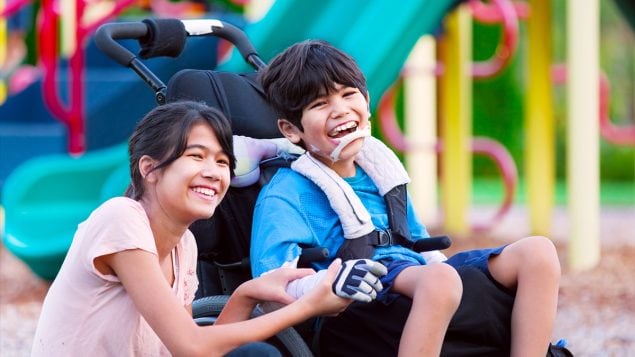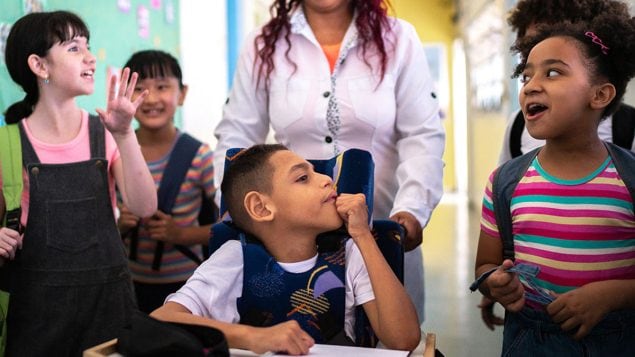What is Cerebral Palsy?
Cerebral palsy (CP) is a group of disorders that affect a person’s ability to move and maintain balance and posture. CP is the most common motor disability in childhood. Cerebral means having to do with the brain. Palsy means weakness or problems with using the muscles. CP is caused by abnormal brain development or damage to the developing brain that affects a person’s ability to control his or her muscles.
The symptoms of CP vary from person to person. A person with severe CP might need to use special equipment to be able to walk, or might not be able to walk at all and might need lifelong care. A person with mild CP, on the other hand, might walk a little awkwardly, but might not need any special help. CP does not get worse over time, though the exact symptoms can change over a person’s lifetime.
All people with CP have problems with movement and posture. Many also have related conditions such as intellectual disability; seizures; problems with vision, hearing, or speech; changes in the spine (such as scoliosis); or joint problems (such as contractures).

Types of Cerebral Palsy
Doctors classify CP according to the main type of movement disorder involved. Depending on which areas of the brain are affected, one or more of the following movement disorders can occur:
- Stiff muscles (spasticity)
- Uncontrollable movements (dyskinesia)
- Poor balance and coordination (ataxia)
There are four main types of CP:
Spastic Cerebral Palsy
The most common type of CP is spastic CP. Spastic CP affects about 80% of people with CP.
People with spastic CP have increased muscle tone. This means their muscles are stiff and, as a result, their movements can be awkward. Spastic CP usually is described by what parts of the body are affected:
- Spastic diplegia/diparesis―In this type of CP, muscle stiffness is mainly in the legs, with the arms less affected or not affected at all. People with spastic diplegia might have difficulty walking because tight hip and leg muscles cause their legs to pull together, turn inward, and cross at the knees (also known as scissoring).
- Spastic hemiplegia/hemiparesis―This type of CP affects only one side of a person’s body; usually the arm is more affected than the leg.
- Spastic quadriplegia/quadriparesis―Spastic quadriplegia is the most severe form of spastic CP and affects all four limbs, the trunk, and the face. People with spastic quadriparesis usually cannot walk and often have other developmental disabilities such as intellectual disability; seizures; or problems with vision, hearing, or speech.
Dyskinetic Cerebral Palsy (also includes athetoid, choreoathetoid, and dystonic cerebral palsies)
People with dyskinetic CP have problems controlling the movement of their hands, arms, feet, and legs, making it difficult to sit and walk. The movements are uncontrollable and can be slow and writhing or rapid and jerky. Sometimes the face and tongue are affected and the person has a hard time sucking, swallowing, and talking. A person with dyskinetic CP has muscle tone that can change (varying from too tight to too loose) not only from day to day, but even during a single day.
Ataxic Cerebral Palsy
People with ataxic CP have problems with balance and coordination. They might be unsteady when they walk. They might have a hard time with quick movements or movements that need a lot of control, like writing. They might have a hard time controlling their hands or arms when they reach for something.
Mixed Cerebral Palsy
Some people have symptoms of more than one type of CP. The most common type of mixed CP is spastic-dyskinetic CP.
Early Signs
The signs of CP vary greatly because there are many different types and levels of disability. The main sign that a child might have CP is a delay reaching motor or movement milestones (such as rolling over, sitting, standing, or walking). Following are some other signs of possible CP. It is important to note that some children without CP also might have some of these signs.
In a Baby Younger Than 6 Months of Age
- His head lags when you pick him up while he’s lying on his back
- He feels stiff
- He feels floppy
- When held cradled in your arms, he seems to overextend his back and neck, constantly acting as if he is pushing away from you
- When you pick him up, his legs get stiff and they cross or scissor
In a Baby Older Than 6 Months of Age
- She doesn’t roll over in either direction
- She cannot bring her hands together
- She has difficulty bringing her hands to her mouth
- She reaches out with only one hand while keeping the other fisted
In a Baby Older Than 10 Months of Age
- He crawls in a lopsided manner, pushing off with one hand and leg while dragging the opposite hand and leg
- He scoots around on his buttocks or hops on his knees, but does not crawl on all fours
Tell your child’s doctor or nurse if you notice any of these signs. Learn more about developmental milestones that children should reach from birth to 5 years of age
Screening and Diagnosis

Diagnosing CP at an early age is important to the well-being of children and their families. Diagnosing CP can take several steps:
Developmental Monitoring
Developmental monitoring (also called surveillance) means tracking a child’s growth and development over time. If any concerns about the child’s development are raised during monitoring, then a developmental screening test should be given as soon as possible.
Developmental Screening
During developmental screening a short test is given to see if the child has specific developmental delays, such as motor or movement delays. If the results of the screening test are cause for concern, then the doctor will make referrals for developmental and medical evaluations.
Developmental and Medical Evaluations
The goal of a developmental evaluation is to diagnose the specific type of disorder that affects a child.
Learn more about screening and diagnosis
Treatments and Intervention Services
There is no cure for CP, but treatment can improve the lives of those who have the condition. It is important to begin a treatment program as early as possible.
After a CP diagnosis is made, a team of health professionals works with the child and family to develop a plan to help the child reach his or her full potential. Common treatments include medicines; surgery; braces; and physical, occupational, and speech therapy. No single treatment is the best one for all children with CP. Before deciding on a treatment plan, it is important to talk with the child’s doctor to understand all the risks and benefits.
Visit the NINDS Cerebral Palsy Information Page to learn more about treatments for CP
Intervention Services
Both early intervention and school-aged services are available through our nation’s special education law—the Individuals with Disabilities Education Act (IDEA). Part C of IDEA deals with early intervention services (birth to 36 months of age), while Part B applies to services for school-aged children (3 to 22 years of age). Even if your child has not been diagnosed with CP, he or she may be eligible for IDEA services.
Learn more about IDEA Services
Causes and Risk Factors
CP is caused by abnormal development of the brain or damage to the developing brain that affects a child’s ability to control his or her muscles. There are several possible causes of the abnormal development or damage. People used to think that CP was mainly caused by lack of oxygen during the birth process. Now, scientists think that this causes only a small number of CP cases.
The abnormal development of the brain or damage that leads to CP can happen before birth, during birth, within a month after birth, or during the first years of a child’s life, while the brain is still developing. CP related to abnormal development of the brain or damage that occurred before or during birth is called congenital CP. The majority of CP (85%–90%) is congenital. In many cases, the specific cause is not known. A small percentage of CP is caused by abnormal development of the brain or damage that occurs more than 28 days after birth. This is called acquired CP, and usually is associated with an infection (such as meningitis) or head injury.
Learn more about causes and risk factors for CP
If You’re Concerned
If you think your child is not meeting movement milestones or might have CP, contact your doctor or nurse and share your concerns.
If you or your doctor is still concerned, ask for a referral to a specialist who can do a more in-depth evaluation of your child and assist in making a diagnosis.
At the same time, call your state’s public early childhood system to request a free evaluation to find out if your child qualifies for intervention services. This is sometimes called a Child Find evaluation. You do not need to wait for a doctor’s referral or a medical diagnosis to make this call.
Where to call for a free evaluation from the state depends on your child’s age:
- If your child is not yet 3 years old, contact your local early intervention system.
You can find the right contact information for your state by calling the Early Childhood Technical Assistance Center (ECTA) at 919-962-2001 or visit the Early Childhood Technical Assistance Center. - If your child is 3 years of age or older, contact your local public school system.
Even if your child is not yet old enough for kindergarten or enrolled in a public school, call your local elementary school or board of education and ask to speak with someone who can help you have your child evaluated.
If you’re not sure who to contact, you can call the Early Childhood Technical Assistance Center (ECTA) at 919-962-2001 or visit the Early Childhood Technical Assistance Center.
American Academy of Pediatrics Healthy Children / Cerebral Palsy
http://www.healthychildren.org/English/health-issues/conditions/developmental-disabilities/pages/Cerebral-Palsy.aspx
American Association on Intellectual and Developmental Disabilities
https://aaidd.org/home
Honeycutt A, Dunlap L, Chen H, Homsi G. Economic costs associated with mental retardation, cerebral palsy, hearing loss, and vision impairment: United States, 2003. MMWR Morb mital Wkly Rep. 2004;53(3): 57-59.
https://www.cdc.gov/mmwr/preview/mmwrhtml/mm5303a4.htm
Identifying Infants and Young Children With Developmental Disorders in the Medical Home: An Algorithm for Developmental Surveillance and Screening. Council on Children With Disabilities, Section on Developmental Behavioral Pediatrics, Bright Futures Steering Committee, Medical Home Initiatives for Children With Special Needs Project Advisory Committee. Pediatrics, July 2006.
http://pediatrics.aappublications.org/content/118/1/405.full.pdf [PDF – 930 KB]
March of Dimes. Cerebral Palsy.
http://www.marchofdimes.org/baby/cerebral-palsy.aspx
My Child Without Limits
http://www.mychildwithoutlimits.org/?page=home
National Institute of Neurological Disorders and Stroke. Cerebral Palsy: Hope Through Research. NIH Publication Number 10-159, updated 5/6/10.
https://www.ninds.nih.gov/Disorders/Patient-Caregiver-Education/Hope-Through-Research/Cerebral-Palsy-Hope-Through-Research
Pellegrino, Louis. Cerebral Palsy, in Batshaw ML, Pellegrino L, Roizen NJ (eds.), Children with Disabilities, 6th Edition, Baltimore, MD, Paul H Brookes Publishing Company, 2007, pp 387-408.